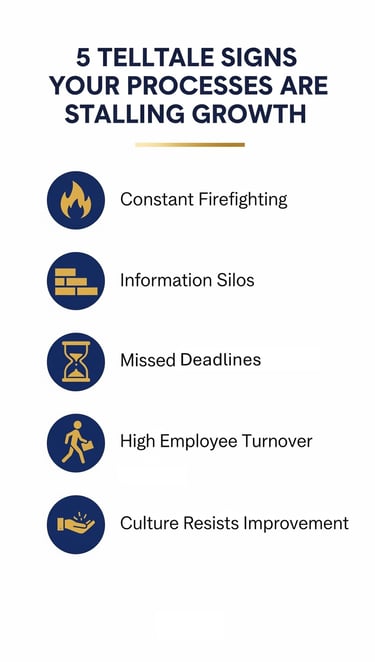5 Signs Your Internal Processes Are Killing Business Growth | SSP
Cody Scardino
8/26/2025


For most ambitious businesses, the greatest threats to growth aren’t out in the market—they’re inside the company walls. Many founders and executives hit an invisible "internal growth ceiling," a point where more effort and longer hours stop producing better results. This ceiling is built from the quiet accumulation of process debt, operational friction, and a lack of clear systems.
If you feel perpetually "stuck in day-to-day execution," you’re not just having a busy quarter; you're experiencing a critical business vulnerability. Addressing these internal failures is a strategic imperative for any leader who wants to get back to working on the business, not just in it. The first step is diagnosis. From our experience embedded inside dozens of companies, we've seen the same warning signs appear again and again.
Here are the five most common telltale signs that your internal processes are the real bottleneck to your growth.


1. Your Calendar is Dominated by Firefighting
The most immediate symptom of broken processes is a leadership team that is constantly overwhelmed. Does your day consist of one emergency call after another? Are "last-minute rush jobs" the rule rather than the exception?
This state of reactive management means you have no time for strategic work. Instead of planning the next quarter, you’re fixing shipping errors. Instead of developing your team, you’re placating an unhappy client whose delivery was delayed. This isn't a sign of a hard-working team; it's the clearest signal that your underlying workflows cannot handle your current business volume, let alone support future growth. It creates a vicious cycle where there’s “no time” for process improvement, trapping the organization in a downward spiral of increasing chaos and burnout.
2. Miscommunication and Silos Are the Norm
"I thought you were handling that." "No one told me that was the new process." "Which spreadsheet are we using?"
If these phrases are common, you’re suffering from a lack of clear communication channels and documented processes. When teams operate in silos, it leads directly to duplicated efforts, costly errors, and project delays. Critical knowledge becomes trapped with a few key employees, creating significant risk and dependency if they leave.
Without a single source of truth for how work gets done, execution becomes inconsistent and error rates climb. This forces the team to rely on manual workarounds and "tribal knowledge," making the business impossible to scale effectively.990
3. You Consistently Miss Deadlines and Delivery Dates
Are you struggling with excessive lead times? Do you frequently fail to deliver products or services on schedule? This is a massive red flag that points to systemic bottlenecks.
Often, the problem isn't one single thing but a chain reaction of small inefficiencies. A delay in one department has a cascading effect on all the others, but without clear processes, it's impossible to trace the problem to its root cause. As a result, customer feedback starts shifting from the quality of your work to complaints about delays. In a competitive market, a reputation for being unreliable is a death sentence.
4. You Have High Employee Turnover and Burnout
Your best people want to do great work, but inefficient processes, cumbersome workarounds, and the need for constant overtime create a deeply frustrating environment. When talented new hires join your company and see chaotic workflows, they often "run away as soon as they see" them because their expectations for professional operations aren't met.
From our operator's perspective, once voluntary turnover climbs past the 10-15% annual mark, it becomes one of the most expensive and damaging symptoms of operational chaos. It’s a flashing red light indicating that your internal friction is burning out your most valuable asset: your team.
5. "That's Just How It Works Here" is a Common Refrain
Perhaps the most dangerous symptom of all is the cultural normalization of inefficiency. When your team accepts manual workarounds, outdated systems, and broken processes as "standard procedure," you’ve developed an organizational resistance to improvement that is incredibly difficult to overcome.
This mindset signals that the team has given up on the possibility of a better way. It stifles innovation and creates a culture of stagnation. Growth requires a commitment to continuous improvement, and that starts with challenging the idea that "good enough" is ever truly good enough.
Moving from Diagnosis to Action
Recognizing these signs in your own business is the critical first step. The good news is that these are not personal failings; they are systems problems that can be solved with a deliberate, operator-led approach.
By systematically documenting your core processes, establishing clear metrics for success, and building a culture of accountability, you can dismantle the internal growth ceiling. You can break free from the daily firefighting and finally create the space your leadership team needs to drive the business forward.
About the Author
Cody Scardino is a Partner of Scardino Strategic Partners. A former U.S. Army Ranger, he now embeds within businesses to build the disciplined systems leaders need to scale beyond chaos and free themselves from operational drag.
Growth
Driving your growth with clear, data-driven insights.
Success
connect@scardinostrategic.com
© 2025 Scardino Strategic Partners. All rights reserved.
Partner